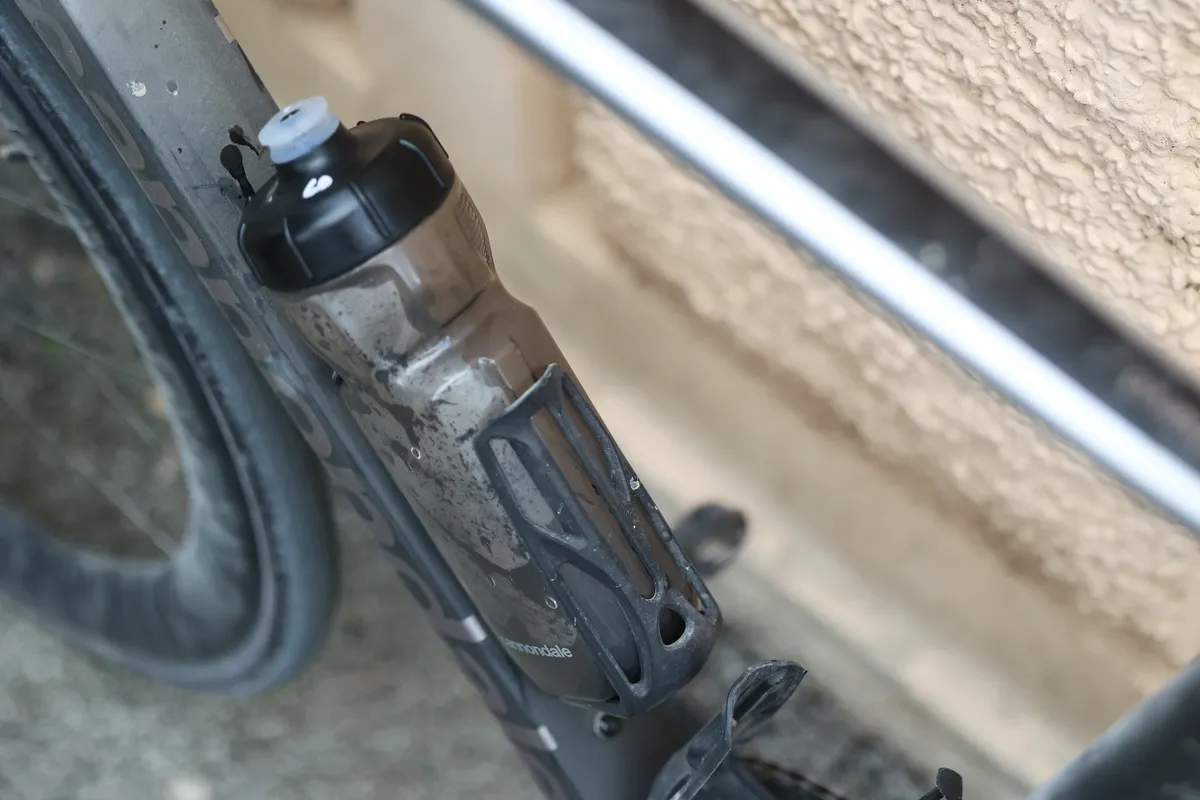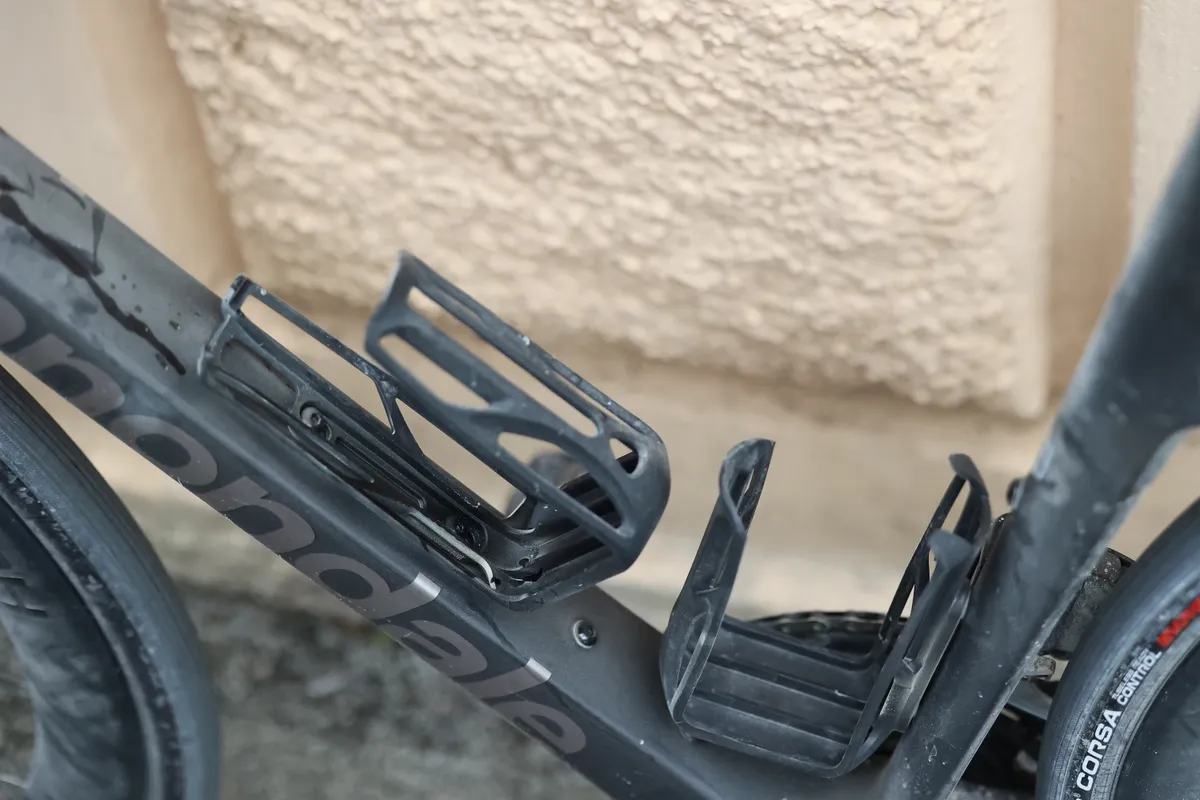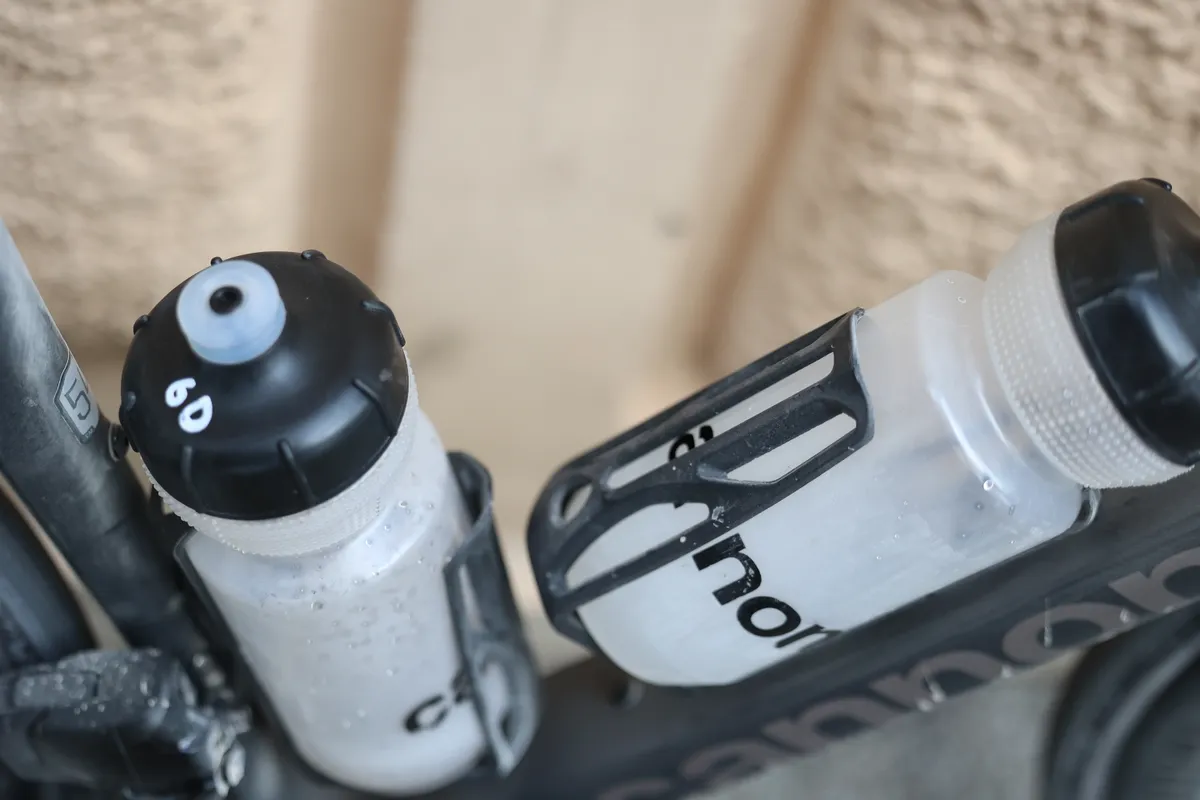As the gradient kicks up to 20 per cent, the rear wheel of the rider in front slips on the loose gravel beneath the tyre. The pedals jump forward, bucking the tired body out of the saddle. He wobbles, then topples and, in slow-motion, makes his way to the ground for an involuntary inspection of Tuscany’s white gravel roads.
I’m on the final gravel climb of the Gran Fondo Strade Bianche, the amateur sportive that takes place on the same roads as the Italian one-day Classic, but 24 hours after the pros.
The Strade Bianche, contested over the ‘white roads’ that give the race its name, has already earned near-Monument status, despite being won for the first time by Alexandr Kolobnev in 2007. Now it serves as the aperitif to the Classics season that follows and, this spring, 7,000 riders – me included – flocked to the region to ride the corresponding sportive.
The forlorn faller dusts himself down and remounts as I grind past, searching once again for another gear at the top of the cassette. There is no extra gear – there never is, when you really need one. But while the climbs are steep around here, they’re mercifully short, too, and I crest the summit, ready to go again one last time as the hilltop finish in Siena looms into view.
Ancient roads on an aero bike
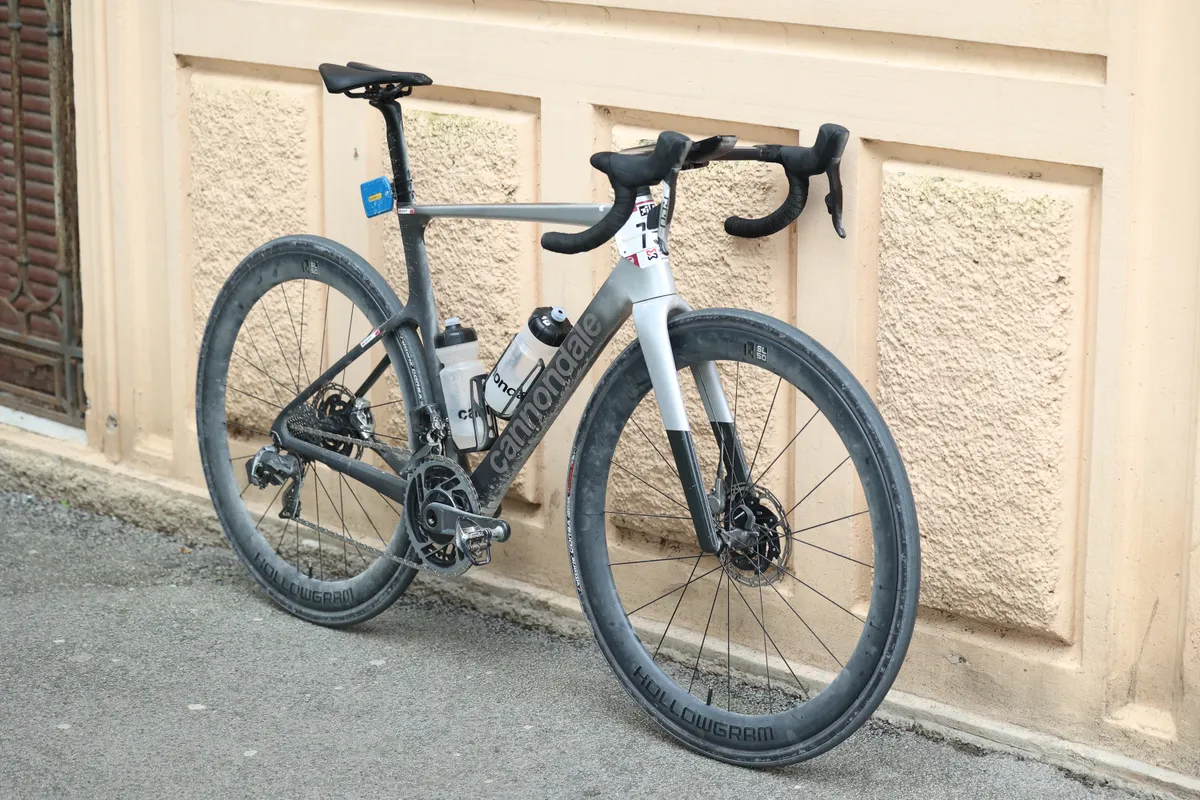
I’d arrived in Siena four days earlier to join the training camp guests of Team EF Coaching. My guides for the week would be Zack Morris, the director of the coaching company attached to the WorldTour team, and Michael Valgren, the EF Education–EasyPost pro, who finished 11th at Strade Bianche in 2022.
The agenda is simple: recce each of the gran fondo’s nine gravel sectors before a weekend double-header of watching the pro race and, finally, riding the amateur event.
The Strade Bianche was borne out of L’Eroica, the vintage event which, since 1997, has also taken place on Italy's gravel roads, but for which riders are required to use bikes dating from before 1988.
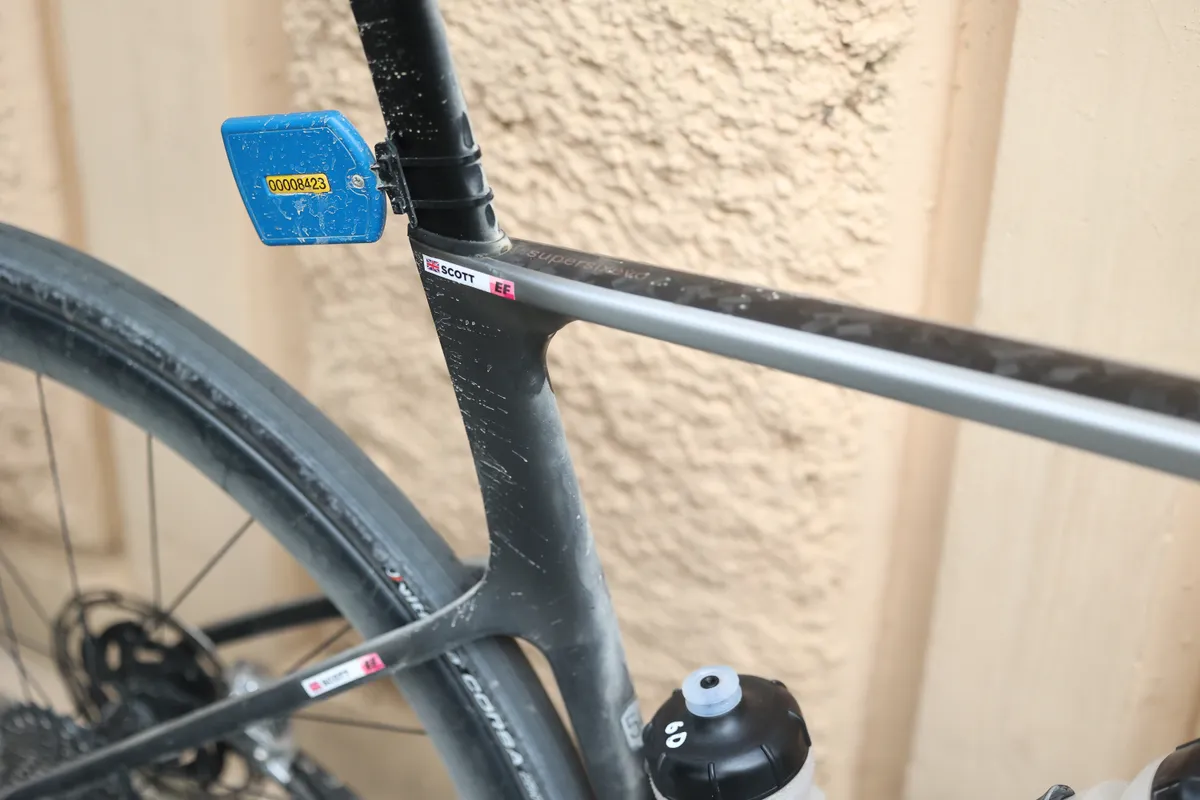
Think steel frames, down-tube shifters and gearing better suited to a pan-flat café run than the profile served up by any ride near Siena, the medieval Tuscan city perched proudly above the surrounding countryside.
I’ve taken the opposite approach to the hardy participants of L’Eroica and have opted for Cannondale’s new SuperSix Evo Hi-Mod, launched in early March ahead of the event, swapping round-tubed steel for aero-profiled carbon fibre; skinny tubular tyres for wide 30c rubber; and down-tube shifters for a wireless electronic groupset.
Be prepared
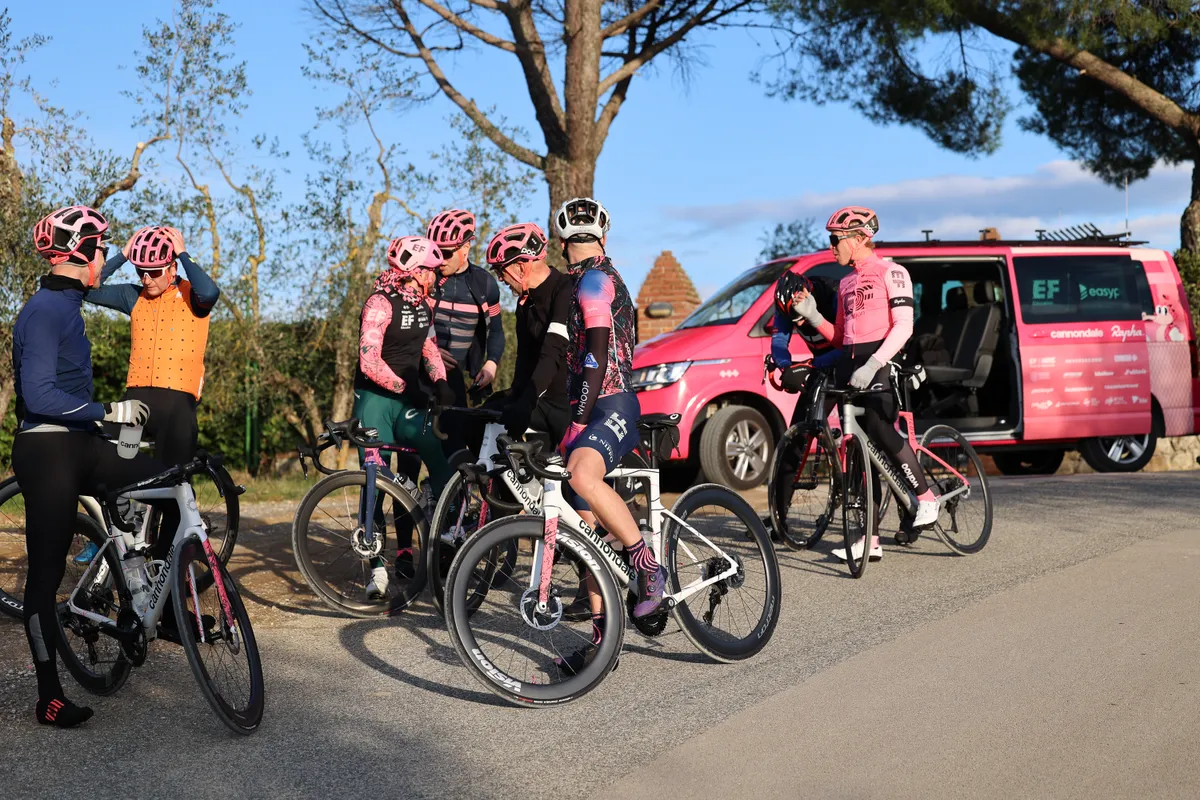
While the men’s pro race is contested over an 184km course, the gran fondo pits riders against a 138km route, which largely matches that of the elite women’s race.
Over the course of three recce rides, we take in all of the 41.8km of unpaved roads that punctuate the route: to prepare for what’s awaiting on Sunday, but also to understand why this part of Tuscany has established itself as part of cycling’s folklore.
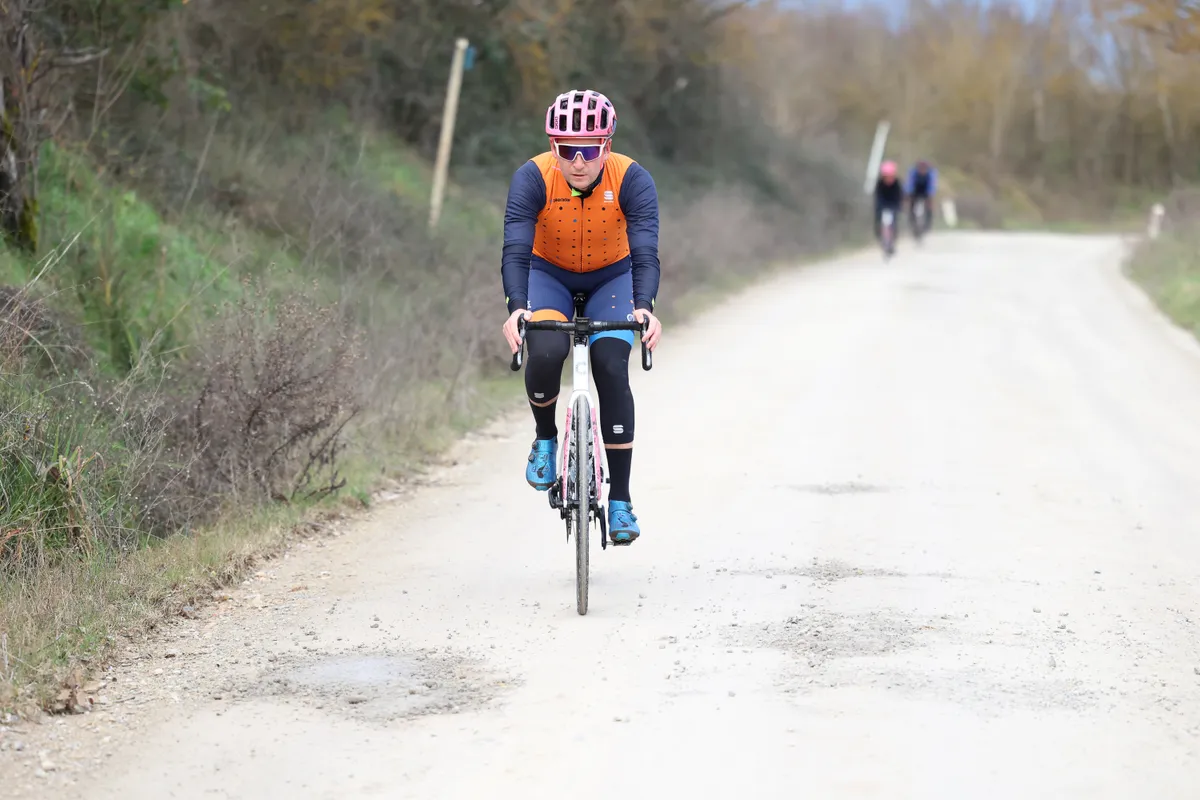
The Strade Bianche runs through the Crete Senesi area south of Siena. Translating to the ‘clays of Siena’, the grey soil gives the landscape its lunar-like appearance. Indeed, every year the Strade Bianche conjures some of the most striking – and beautiful – images of the pro cycling season, dust clouds billowing above the peloton as it hits the gravel.
If the recce rides teach me one thing ahead of the gran fondo, it’s that, while the majority of the gravel comes during the first half of the route, the punchiest climbs come in the final 40km, via a succession of double-digit ramps.
The final climb in Siena, on the narrow street of Via Santa Caterina, peaks at 16 per cent, ahead of the finish in the city’s cavernous square, the Piazza del Campo.
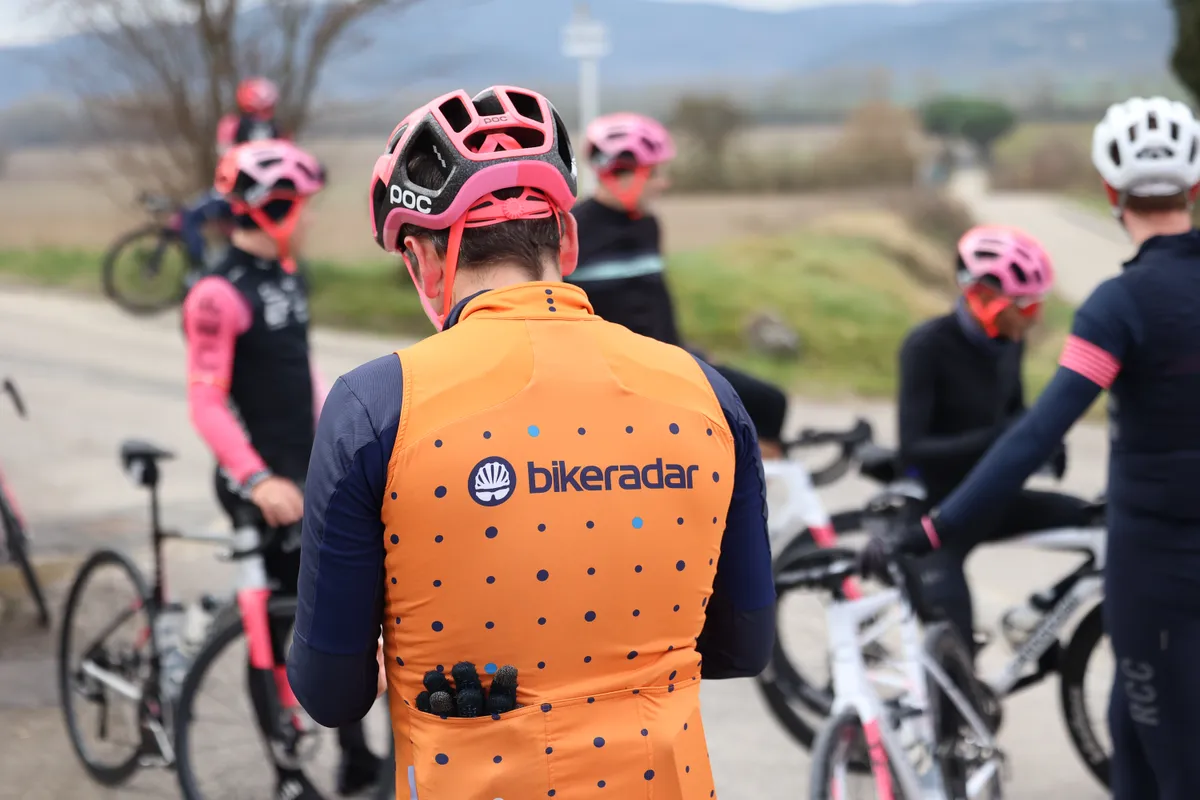
Pidcock paves the way
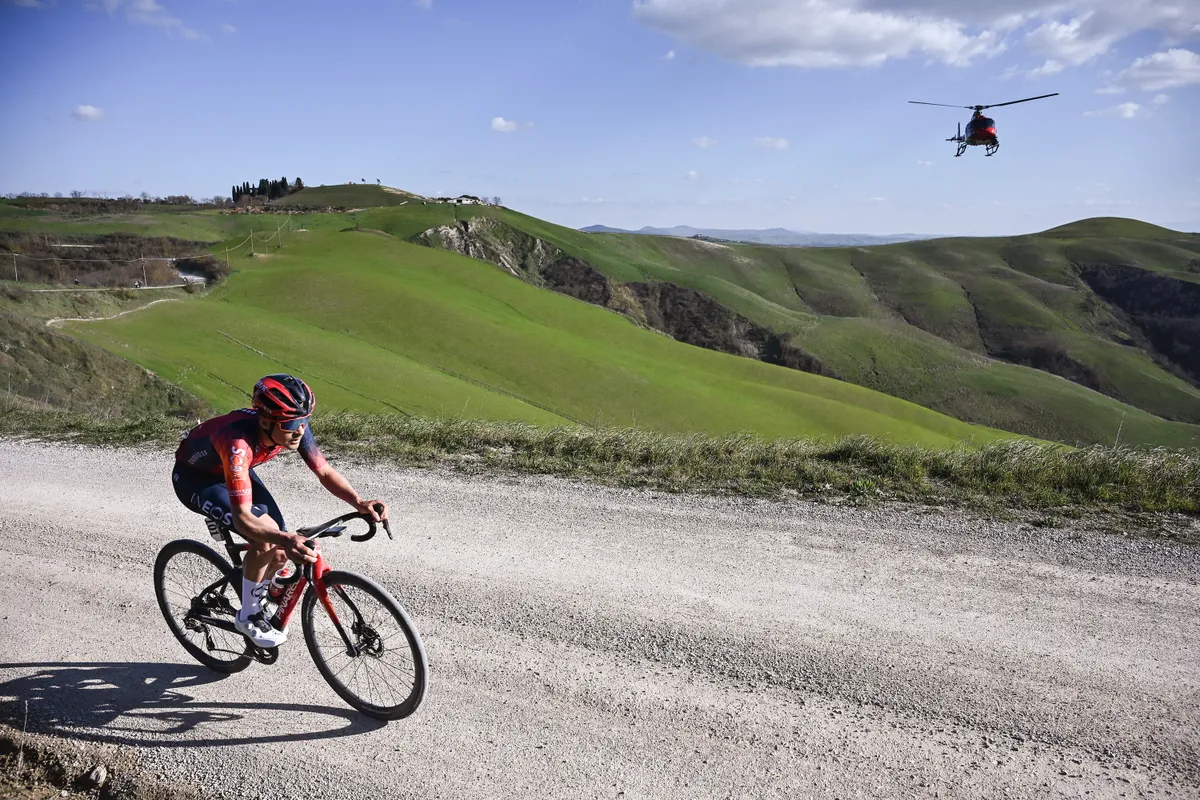
It’s here that I watch Tom Pidcock solo to victory in the men’s race. The Ineos-Grenadiers rider has been on the attack for 45km and arrives in the heart of Siena, 20 seconds ahead of the chase group.
From the Piazza del Campo, I watch Pidcock make the final turn on the big screen that has had thousands of spectators glued to the action. He appears at the elevated edge of the sloping square before free-wheeling, arms aloft, to the finish beneath the Torre del Mangia clock tower.
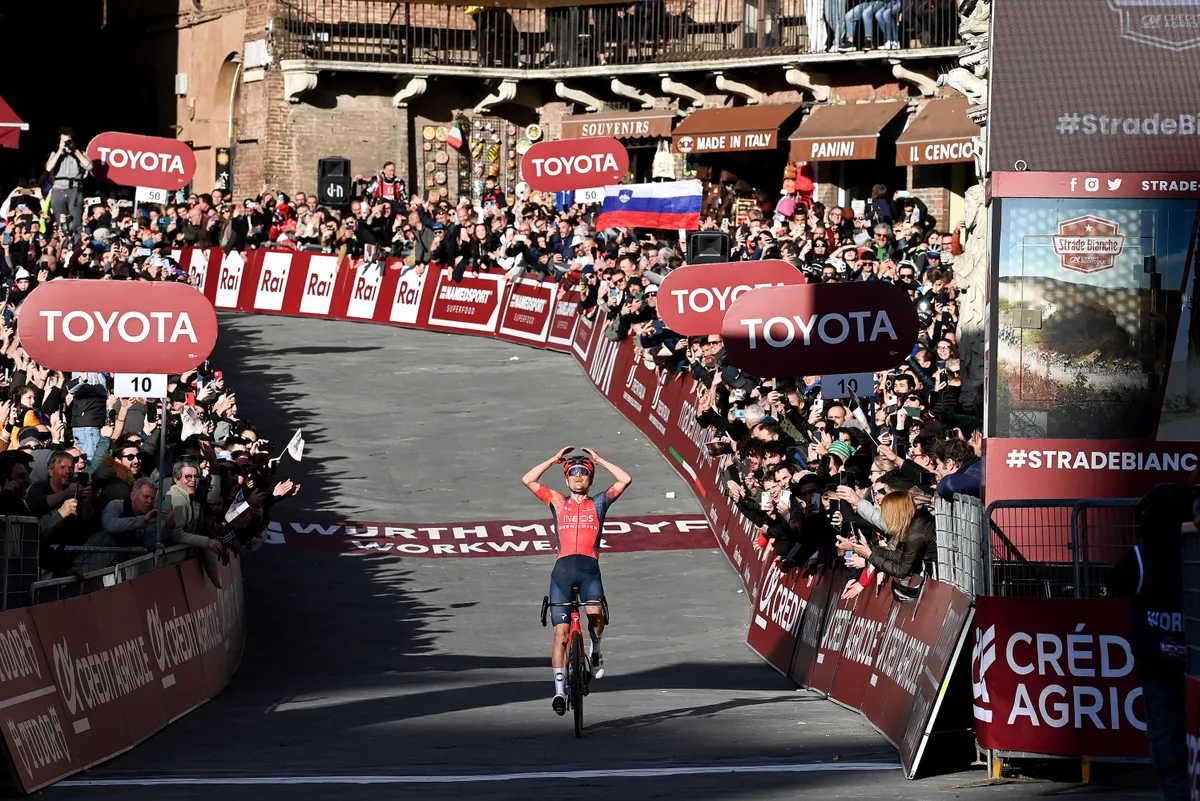
For those of us with Team EF Coaching, this is our final stop of the day. Earlier, we’d embarked on our own race in the EF Education–EasyPost van, jumping between three gravel sectors – with a lunch stop for a generous plate of pici cacio e pepe, thick hand-rolled spaghetti in a cheese and pepper sauce – to watch the race whizz by.
Watching a professional cycling race is typically an experience of contrasts: the slow build of finding a vantage point in a web of closed roads, following the race on the radio or through a patchy live stream on a smartphone, and the growing anticipation that reaches a visceral climax as the television helicopters thud into view. Then the peloton flashes by in seconds.
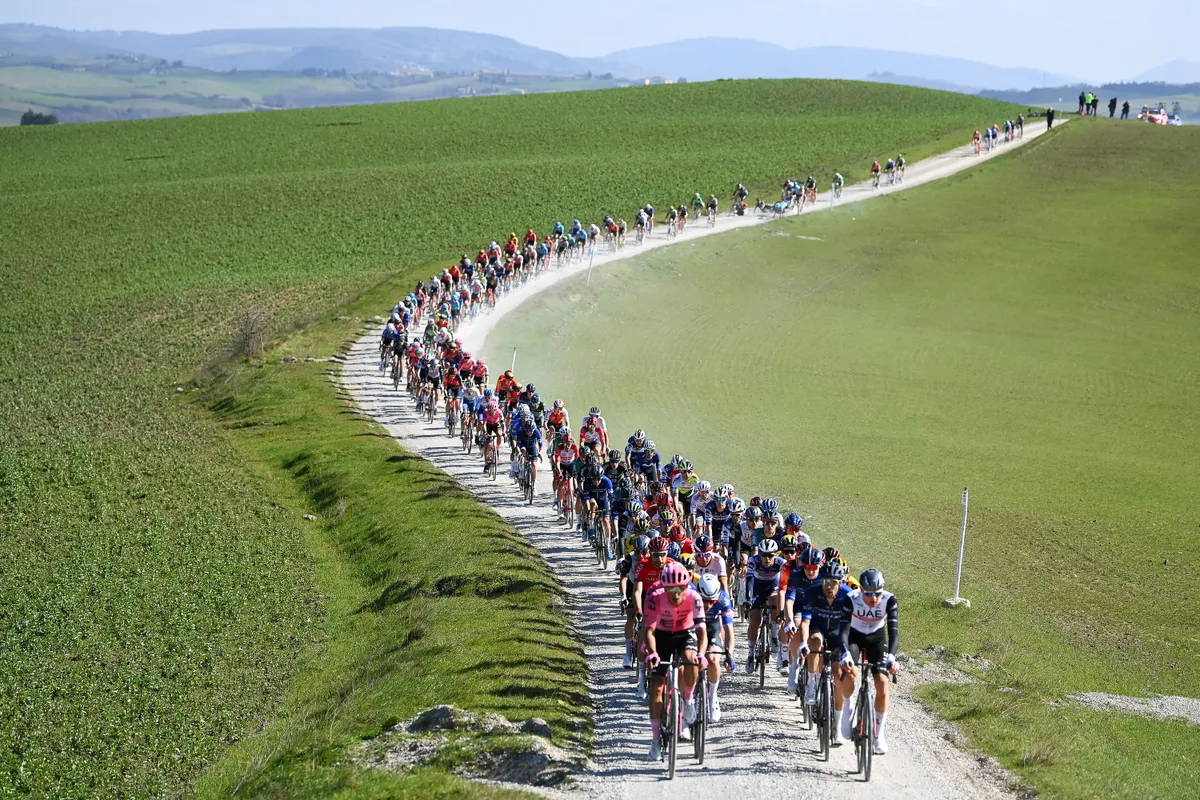
Not at Strade Bianche.
From our earlier vantage point on the climb of San Martino in Grania, the lead group, driven by Ineos-Grenadiers, had, indeed, passed in a flash.
But from there, a strung-out line of chasers fights in vain among team cars to bridge back to the peloton, or, as the minutes pass and the broom wagon approaches, the stragglers jostle for position among the spectators who have now swamped the road to make their way off the climb. Lone riders, jobs done or dreams dashed for the day, look to make their own way back to Siena or find a team soigneur in order to hitch a ride back to the team bus.
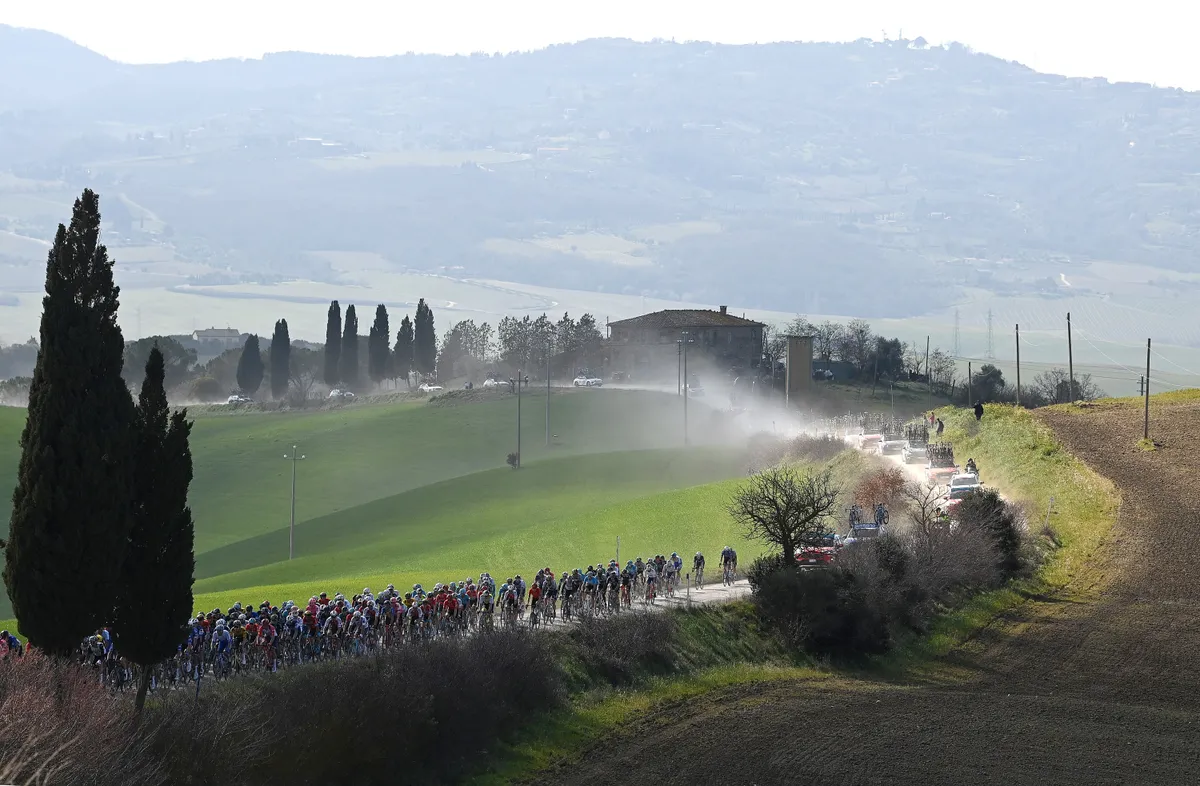
Gran fondo fever
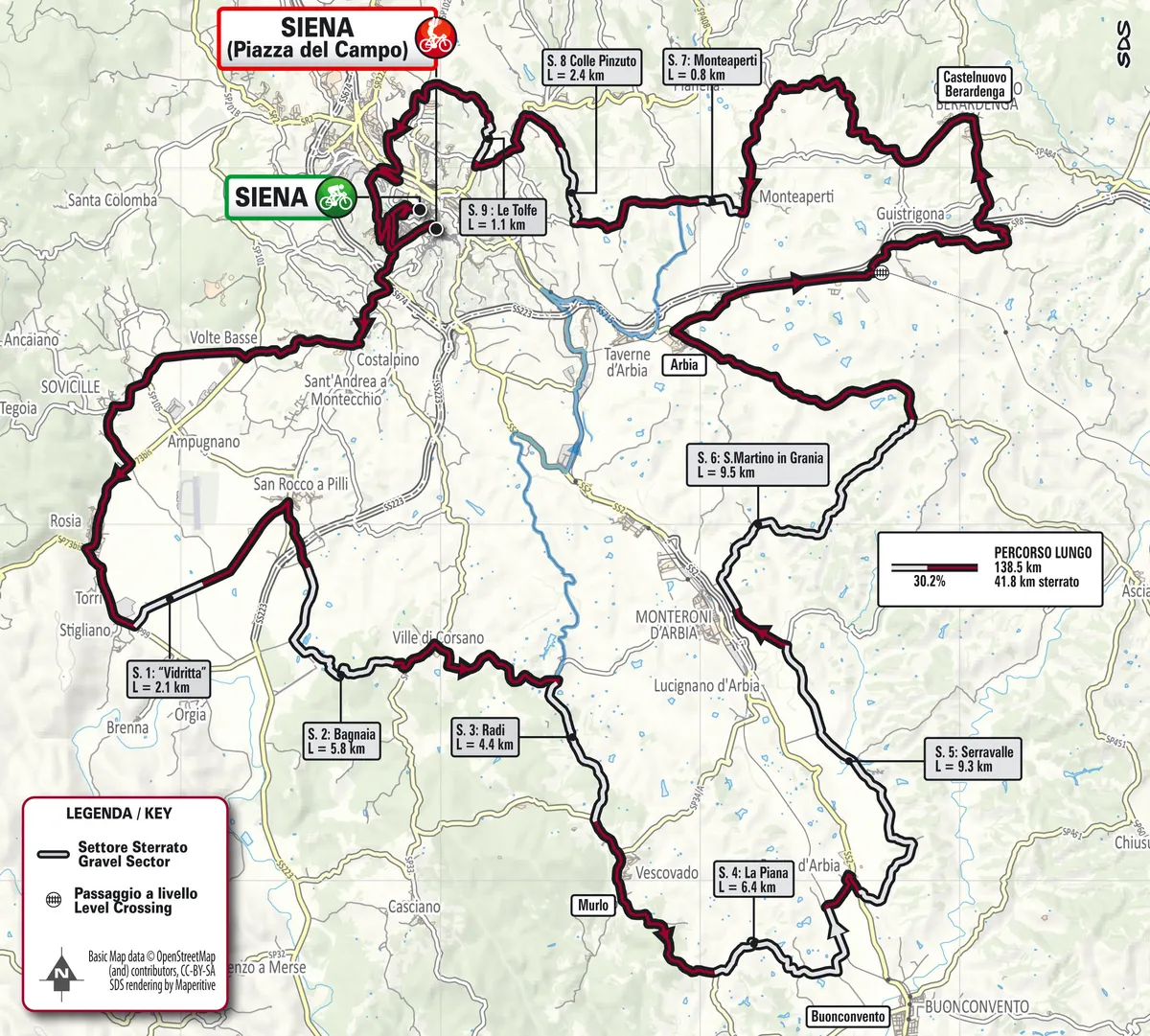
By the time I’m standing at the start line of Sunday’s gran fondo, I’ve recced each of the individual gravel segments and seen how the pros do it – now it’s time to ride the Gran Fondo Strade Bianche.
Italian gran fondo organisers don’t do things by halves and, despite the sun only just rising above the church towers of Siena, and the early-morning temperature in single figures, the atmosphere is red-hot in the city’s Fortezza Medicea, the 16th Century fort serving as the start pen.
“You are strong!”
“Come on guys, all in!”
Against a soundtrack of deafening rock music, the compere is working his vocal chords as hard as I’ll work my legs over the 138km to come.
“Pozzato, Cancellara, Cipollini, Colbrelli, Bettini,” he continues, reeling off the star-studded cast of former pros in the VIP pen, also riding the gran fondo. Cancellara – the Classics legend, aptly nicknamed Spartacus – is the only three-time winner of the men’s elite race, triumphing in 2008, 2012 and 2016. This is doing nothing for my nerves.
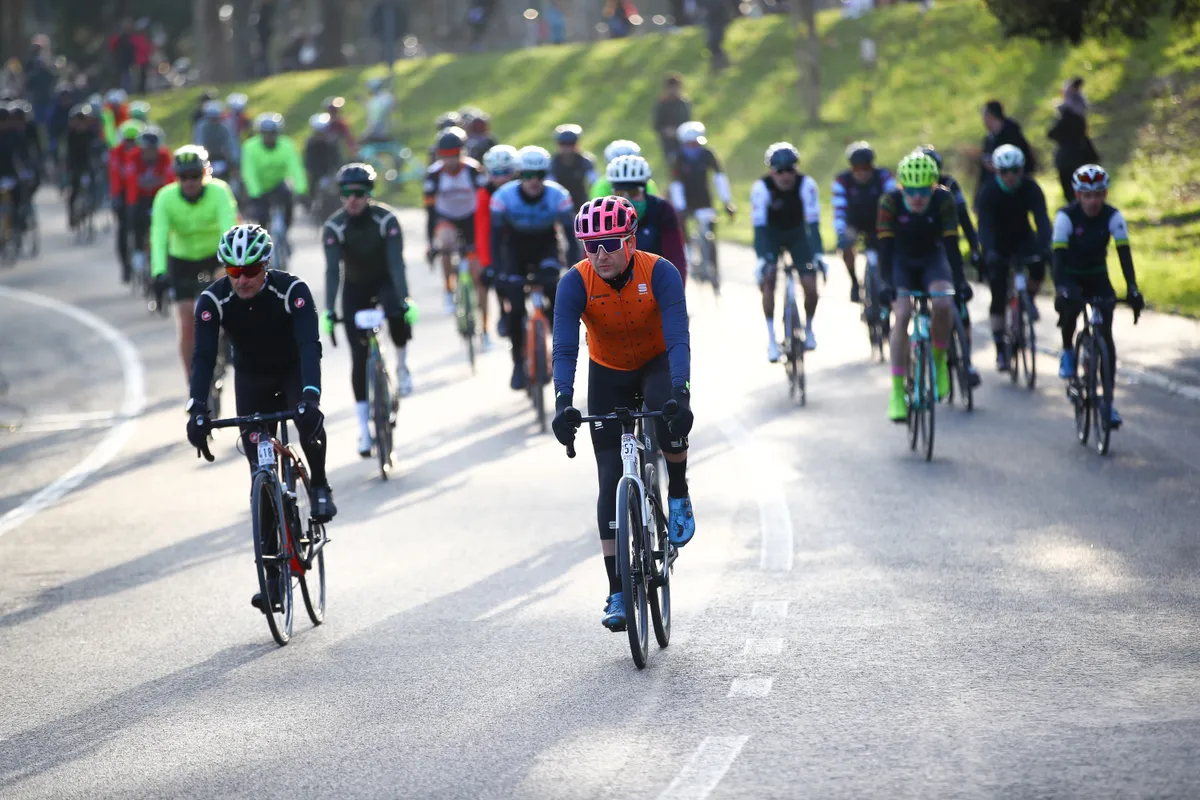
Every rider here is wound tight like a spring and as the flag drops, I hit the short descent out of Siena before finding myself surrounded, once again, by riders in a group as tight as the start pen.
The pace is lightning-fast – as is typical for an Italian gran fondo – but the first section of sterrato, coming after 20km, immediately strings things out.
The Vidritta sector is merely a taste of things to come, rated only 1/5 by the organisers and all slightly downhill. In some respects, it’s like the pavé of Paris-Roubaix, rewarding commitment to a big gear.
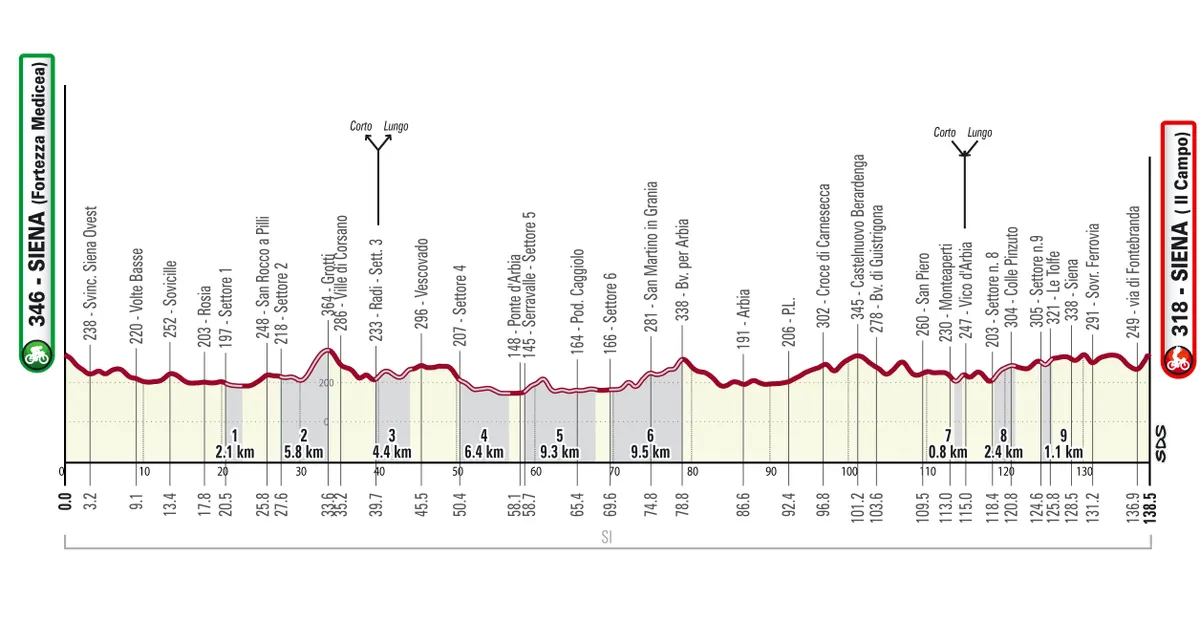
The Bagnia sector that follows offers the first real test. A fast descent that sees me gripping the bars tightly – and hoping my tyres are doing the same on the pockmarked surface below – flows into a 3.2km climb with a rain-rutted surface that immediately saps any momentum.
Bar a couple of double-digit pitches, the ascent is rarely steep, but it’s the kind of climb – early in the route – where it’d be easy to burn through too many matches. This is where the week’s recce rides start to pay off – I know how much climbing we’ve got to come.
Do it yourself
The 2024 Gran Fondo Strade Bianche will take place on Sunday 3 March. Entries are now open via the Gran Fondo Strade Bianche website.
Team EF Coaching's camps are designed to give amateur riders the pro treatment, including massages, mechanic and soigneur support, and the chance to meet the team. For more information on Team EF Coaching's pro-race camps and training plans, head to the Team EF Coaching website.
The Tuscany of postcards
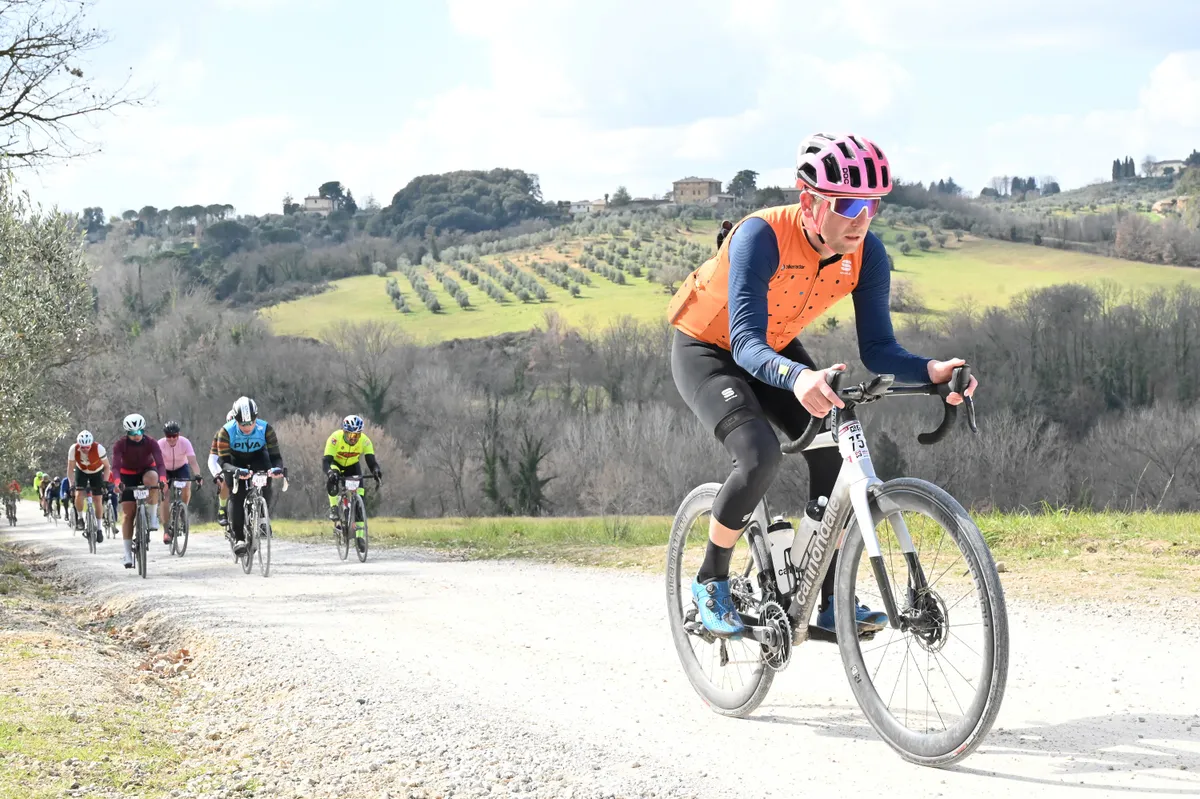
The roads here are rarely flat, but the smooth tarmac between sectors provides some respite before the next two gravel segments. Radi is characterised by a series of punchy rollers that are typical of the area, while La Piana is one of Strade Bianche’s classic stretches, having featured in every edition of the race.
By now, we’re deep into the Tuscan countryside on tracks that see little traffic through the rest of the year.
Mostly downhill, La Piana should be an opportunity to tick off another 6.4km sector with relative ease, but it’s fast and, more to the point, there’s a deep layer of fresh gravel that means grip is a state of mind, rather than a reality.
The road snakes from left to right, with a 180-degree hairpin to contend with, too, and, if you want to carry any speed here, you need to be comfortable with the tyres squirming beneath you. Tuscany? It’s more like Tokyo Drift, and I’m glad I’ve got some extra control – or, rather, more margin for error – through the 30c rubber on my bike, rather than the 23c tyres of days gone by.
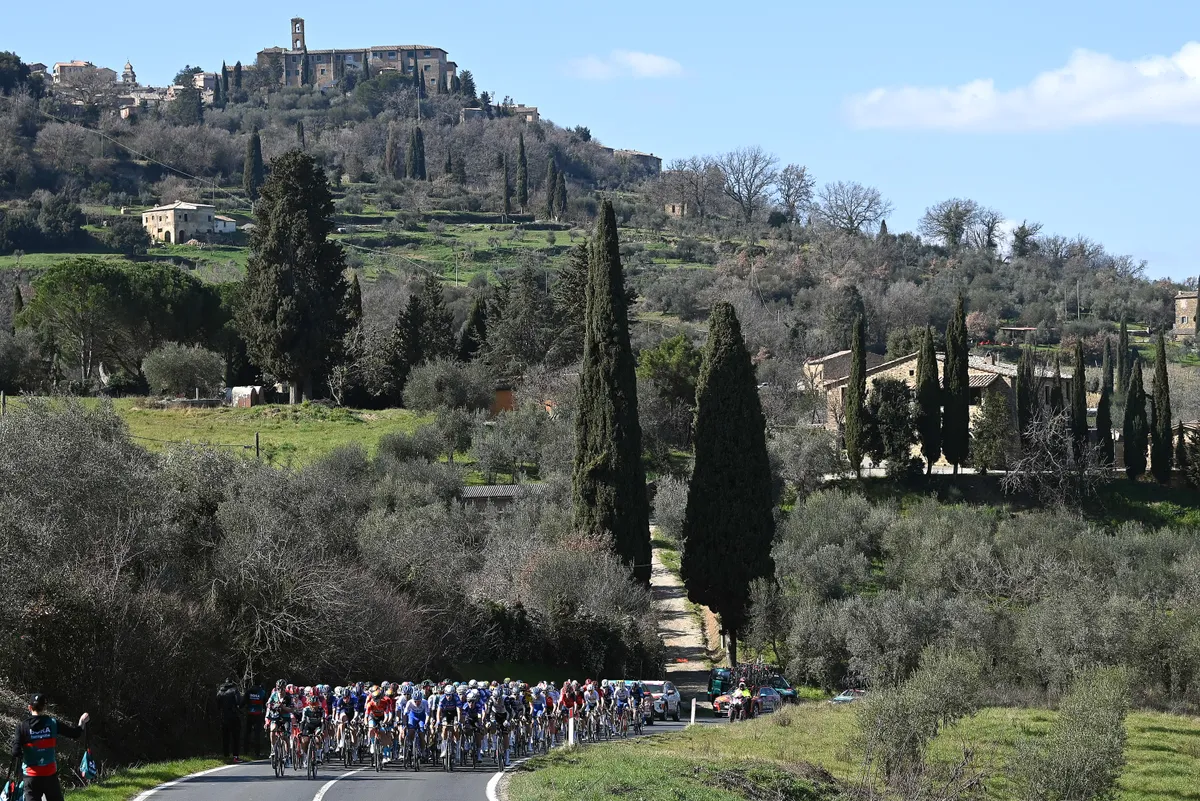
The Serravalle segment arrives and begins with a climb that rises along a tree-lined ridge. This is the Tuscany of postcards – of farmers ploughing the fields, of vineyards awakening from their winter slumber, and of agriturismos giving visitors a taste of la dolce vita.
The gravel road falls into a short but technical descent and then runs flat on a track that has taken its toll beneath the tyres of the tractors that normally service these parts.
Potholes litter the road and require careful navigation – or bunny hops – while long stretches of washboard rattle me to the core – and become a graveyard for dozens of bottles ejected unceremoniously from their cages.
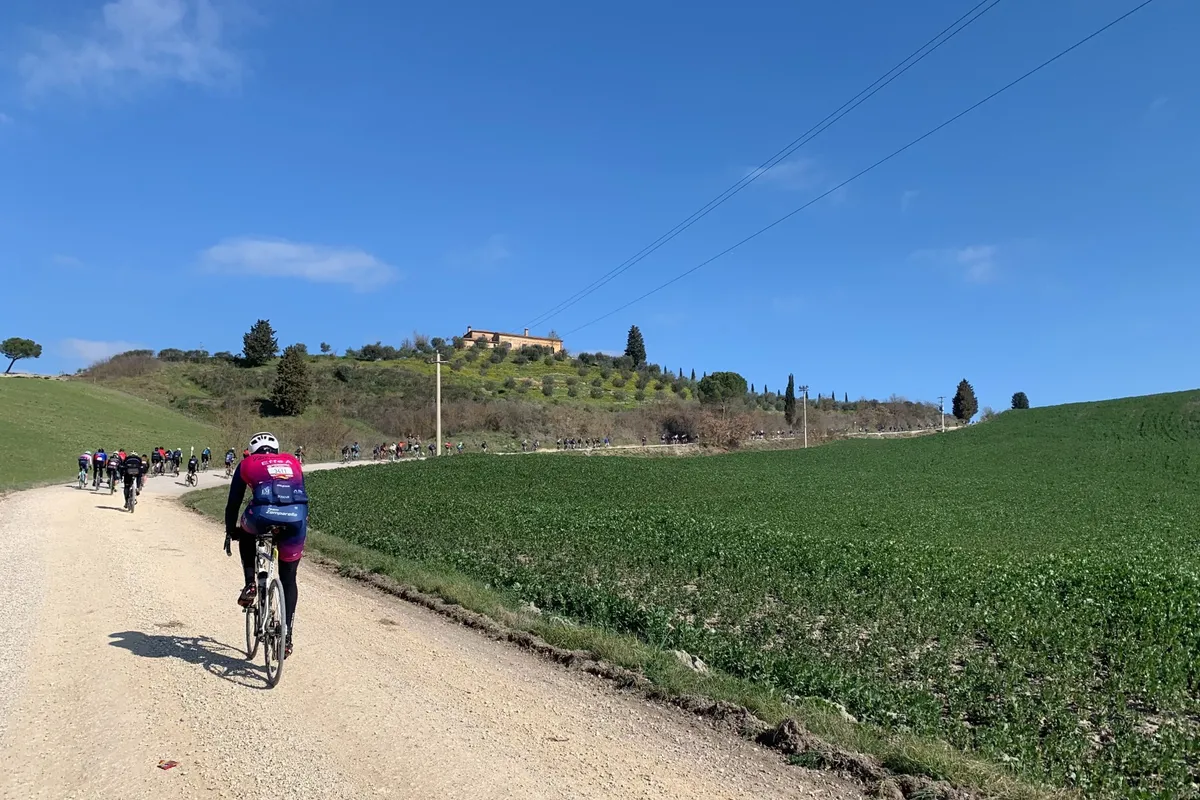
This is the longest gravel sector so far, but the San Martino in Grania segment is longer still at 9.5km. It is also one of the most beautiful stretches of road I’ve ever ridden, paved or otherwise.
We’re in the heart of the Crete Senesi now and the landscape unfolds like a crumpled bedsheet, the rolling hills disappearing into the distance under the haze of the early-spring sunshine, before rising up to meet the snow-capped Apennine Mountains in the north.
A series of tight, steep switchbacks leave me breathless, not only due to the gradient but also because of the remarkable view that stretches as far as the eye can see. Siena sits proudly – ominously – on its hilltop in the distance; behind me, the white road I’ve just climbed hugs the ridge, cutting a path through the spring growth.
San Martino in Grania brings to a close three successive sectors that have served up more than 25km of gravel. A 40km stretch of paved road is to come but, with a nagging headwind and fatigue growing, it turns out to be no free ride.
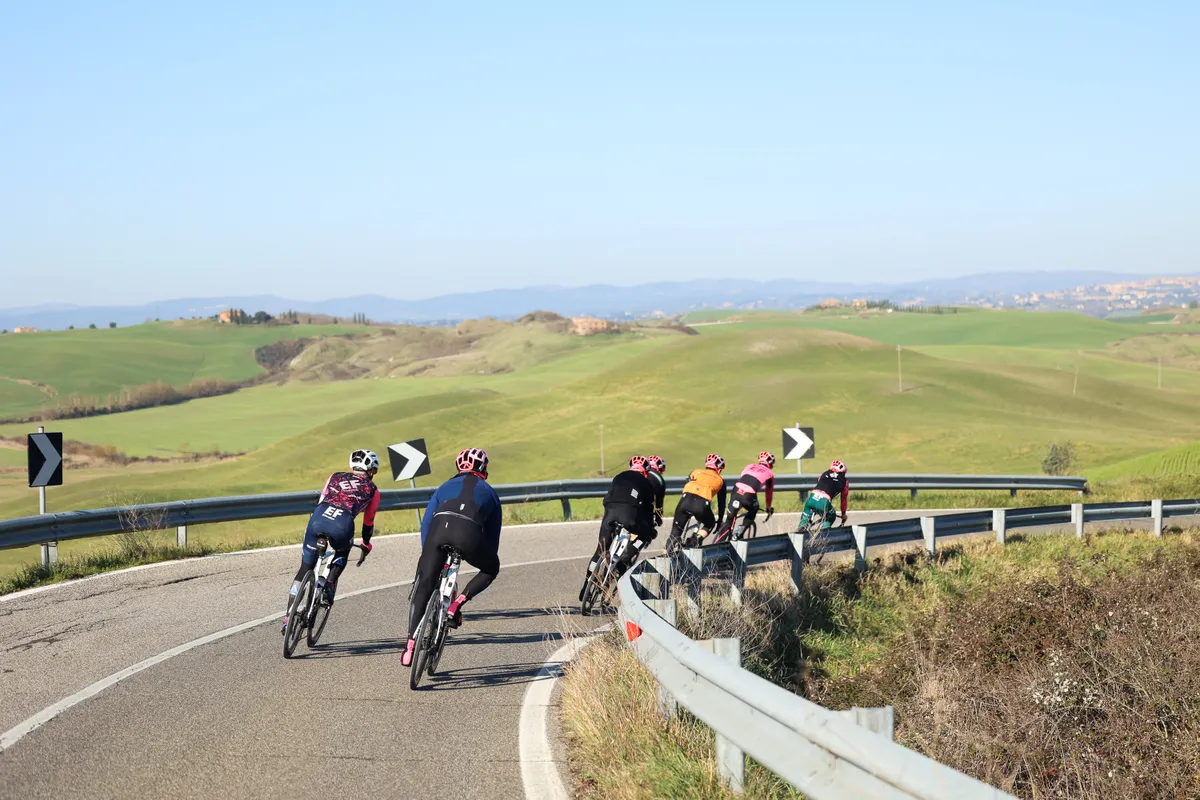
The sting in the tail

If the opening 100km of the Strade Bianche Gran Fondo is generously described as rolling, the final 38.5km is nothing short of sawtooth-like in its profile.
Here, the final three gravel sectors come in quick succession, and each is viciously steep. The first, Monteaperti, is short enough to punch through with gritted teeth, but the second, Colle-Pinzuto, gains more than 100m in elevation and many riders are now walking – or, in my case, riding at walking pace.
The gravel finale comes on Le Tolfe, a rollercoaster ride that starts with a plunging descent, before the road kicks cruelly up. I’m desperately searching for that extra gear, with each push of the pedals now a sinew-straining leg press. With a fine layer of gravel beneath the tyres, there’s no option but to stay seated – rise out of the saddle and you’ll instantly lose traction, as one fallen rider finds out.
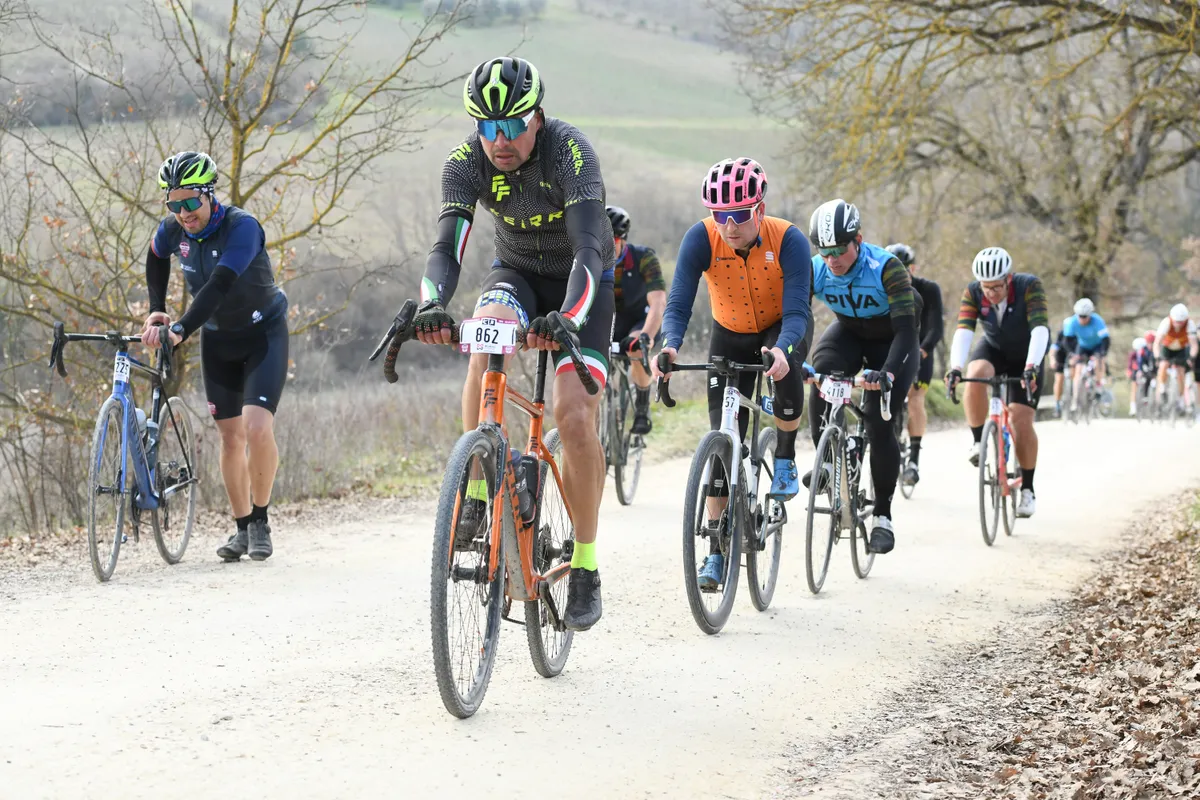
A church stands at the top of the climb and the ascension to its summit, this late in the ride, requires an otherworldly effort. There’s just 14km between La Tolfe and the finish in Siena, but the road continues to rise and fall, before entering the outer city walls and the final climb: Via Santa Caterina.
Strade Bianche’s iconic finish, a narrow passageway that rises steeply to the centre of the city, provides a fitting finale for a race that delivers drama at every turn.
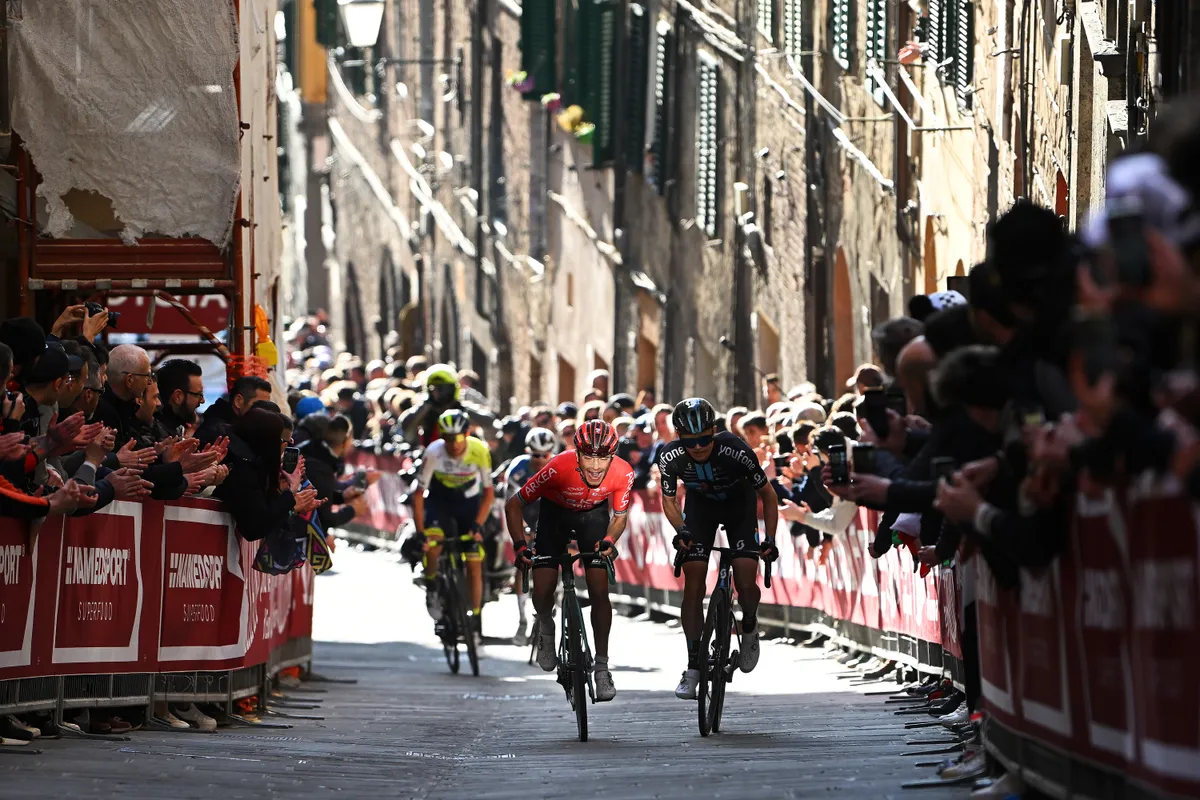
The gradient rises skyward once again, the historic buildings of Siena towering above, and this time the surface has switched from gravel to equally slick polished medieval flagstones.
Locals line the ramp to provide just a hint of the experience felt by Pidcock 24 hours earlier. I’ve got nothing left but adrenaline, but that’s enough here to fuel the final, tank-emptying effort to the finish in the Piazza del Campo.
Horse for the Course | Riding the new Cannondale SuperSix Evo Hi-Mod at the Gran Fondo Strade Bianche
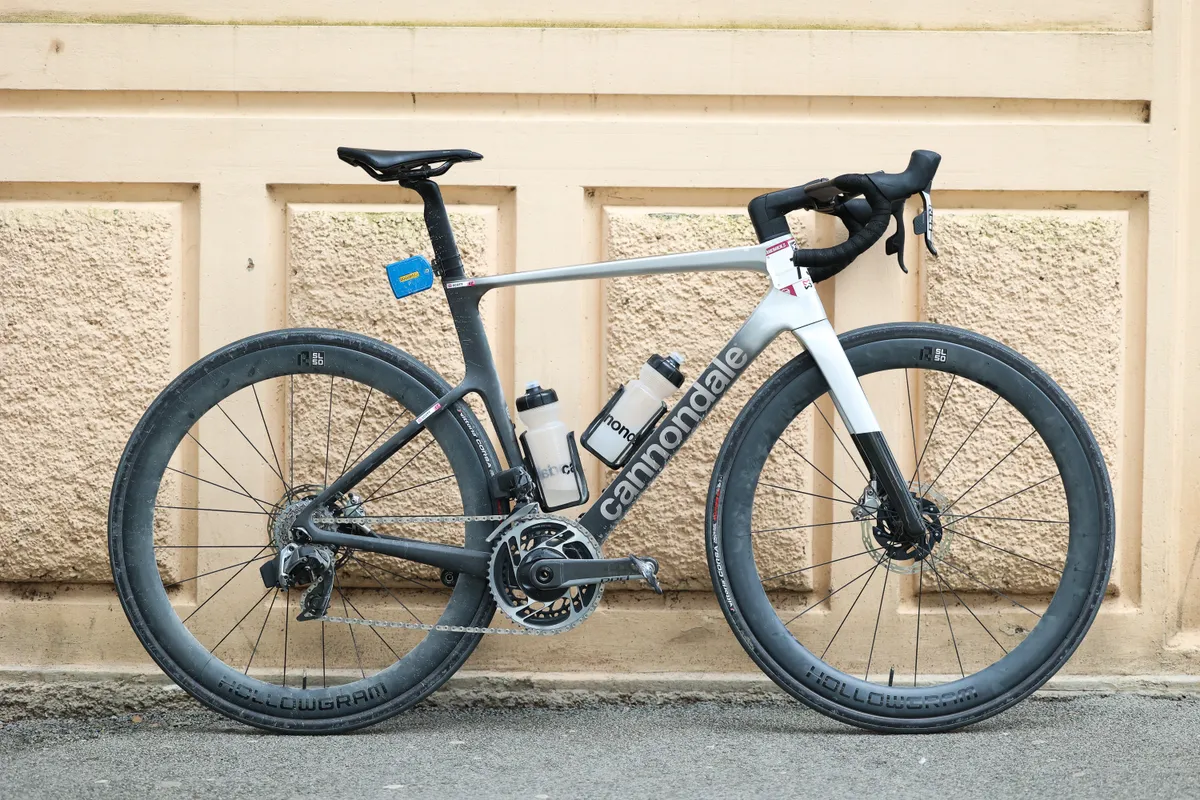
In many respects, the rise of Strade Bianche, since the race’s inception in 2007, has gone hand-in-hand with the evolution of the race bike.
Today’s race bikes – even those designed for WorldTour racing, such as the Cannondale SuperSix Evo Hi-Mod – are more versatile than ever, and at home across varied terrain.
Here’s what I liked, and what I’d change, about my Gran Fondo Strade Bianche whip.
Three things I liked…
Efficient everywhere
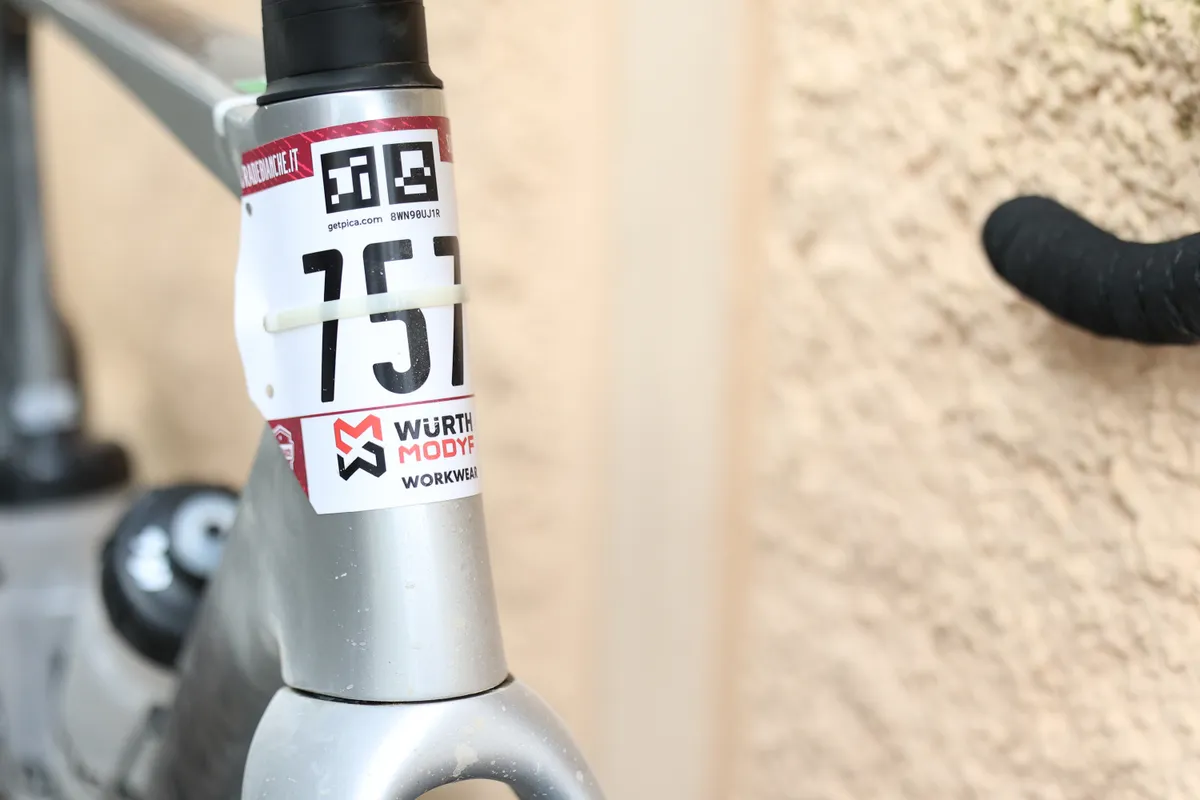
The SuperSix has undergone a transformation over the last few years. Gone are the classic round tubes of old – a move many traditionalists will still mourn – and in are the aero-profiled tubes and hidden hydraulic hoses of the latest edition. This 2023 frame is lighter, too, at a claimed 810g for a 56cm frame, painted and with hardware.
The result of this blend of low weight and aerodynamic prowess is a bike that feels supremely efficient just about everywhere, not least on a rolling course such as the Strade Bianche. That’s an impressive balancing act.
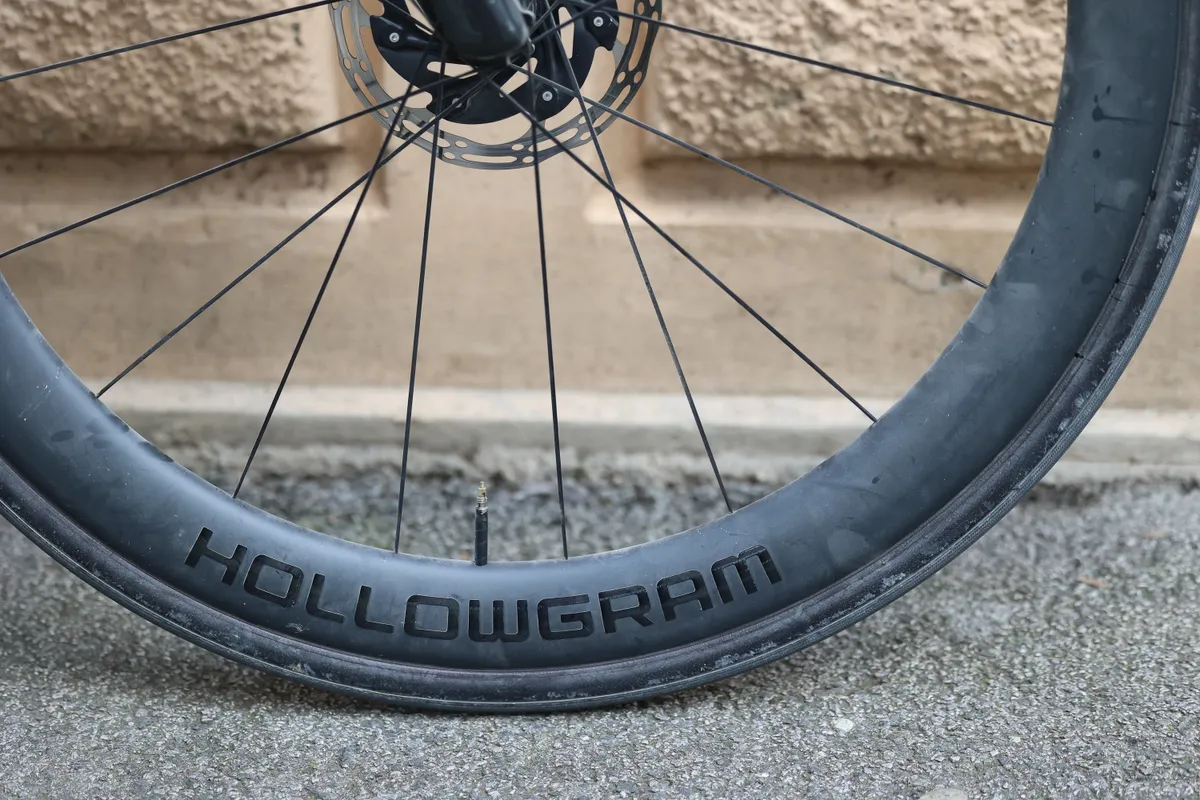
There are no long climbs here, but the ascent accumulates via a relentless series of steep ramps. With a rigid, lightweight chassis at its heart, and poised handling for the technical descents on the other side, the SuperSix did a fine job of seeing off everything thrown at it with no fuss whatsoever.
This is a bike that ticks off the kilometres with relative ease, whether punching uphill, carving downhill or fighting a headwind on the flats.
Gravel-friendly clearance
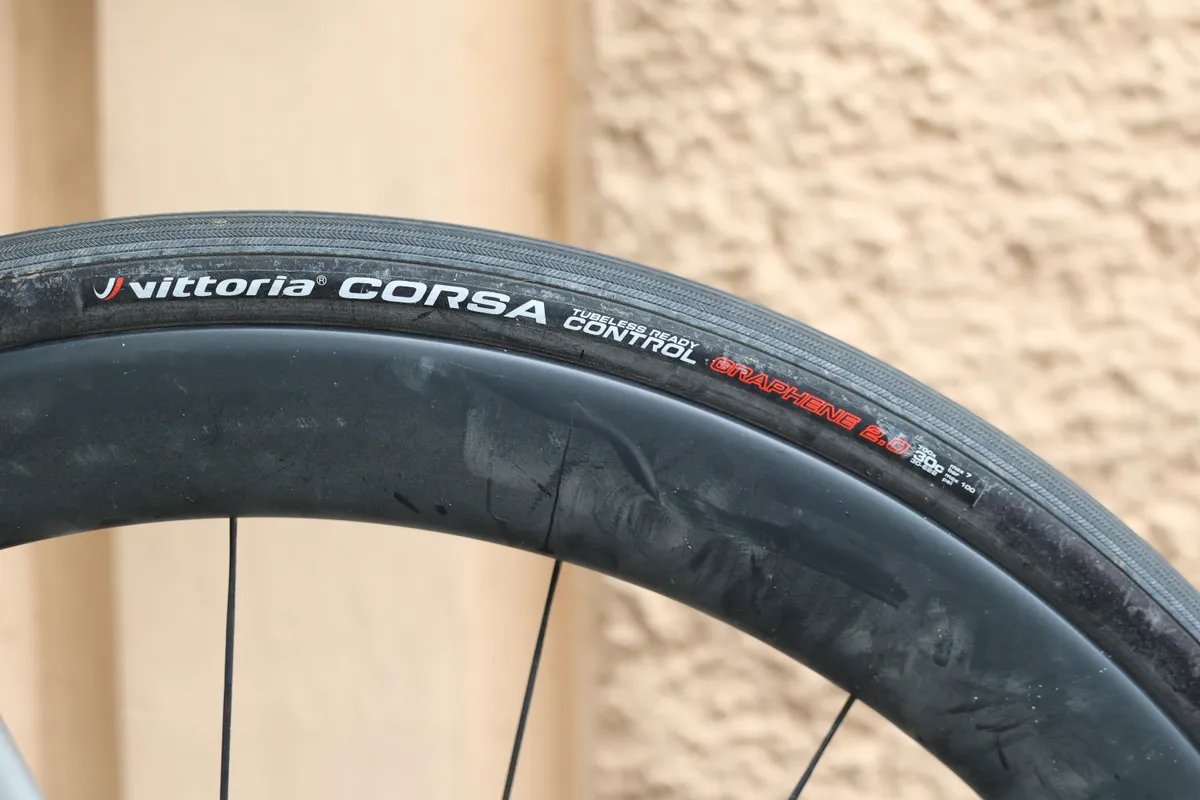
The Gran Fondo Strade Bianche serves up a wide variety of ‘gravel’ over the course of its nine sterrato sectors. Compact dirt roads nearly as smooth as tarmac; deeply-rutted roads that have fallen victim to spring storms; filling-rattling washboard; tyre-deep gravel ready to catch out a careless rider; and everything in between.
Let’s be clear, you could ride the roads around here on the rim-braked, narrow-tyred bikes of the inaugural edition nearly two decades ago – I’m assuming a dry day here – but the gravel-friendly clearance of today’s machines makes the Strade Bianche a more comfortable, more confidence-inspiring and, I’d wager, faster experience.
I asked for 30c tyres to be fitted in place of the supplied 28c rubber on the eve of the event, and was glad I did. There is nothing to lose by going wider here.
Oh, and top marks to the Vittoria Corsa Control tyres, set up with inner tubes, for going the distance without any punctures. They're not the quickest tyres out there, but some additional protection is a smart move here.
Seamless SRAM shifting
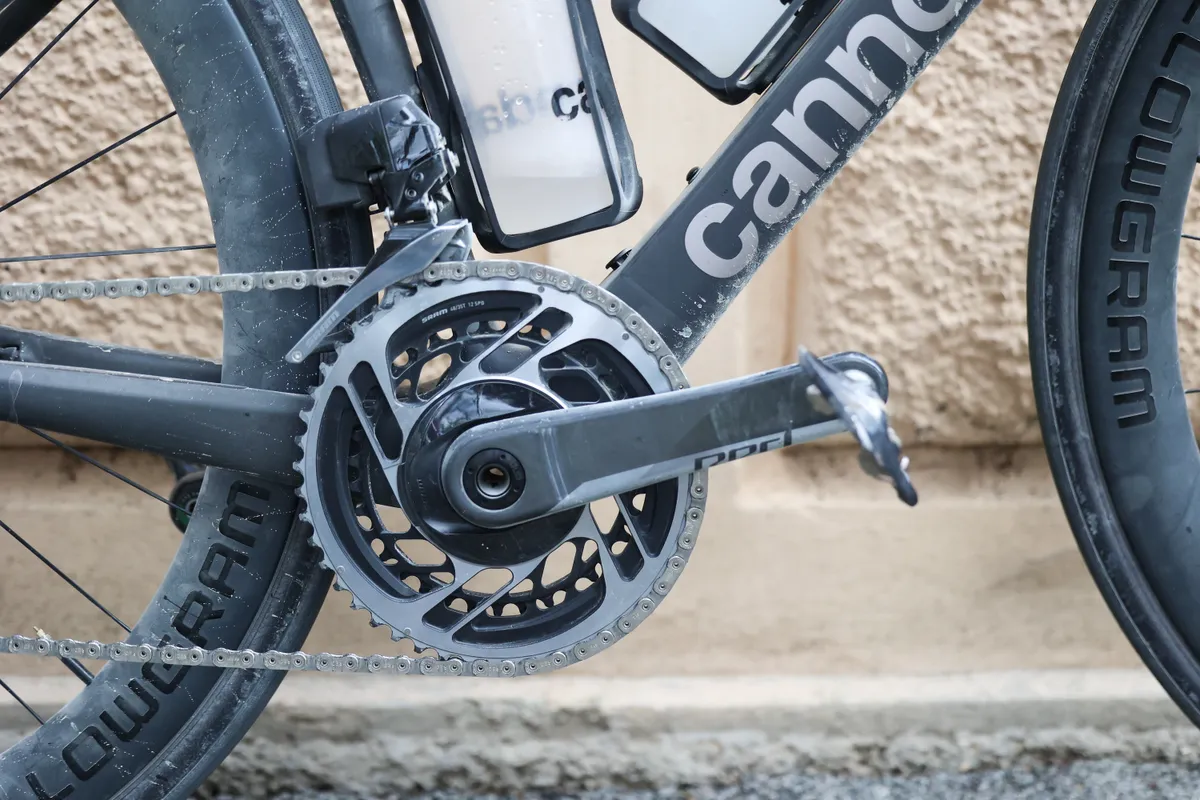
Okay, I’ll keep this short – SRAM’s Red AXS didn’t miss a beat throughout, as much as I tried to churn through the gears with mistimed shifts on the Strade Bianche’s steeper pitches.
But there’s one key change I’d make if heading back.
…and three things I'd change
More generous gearing
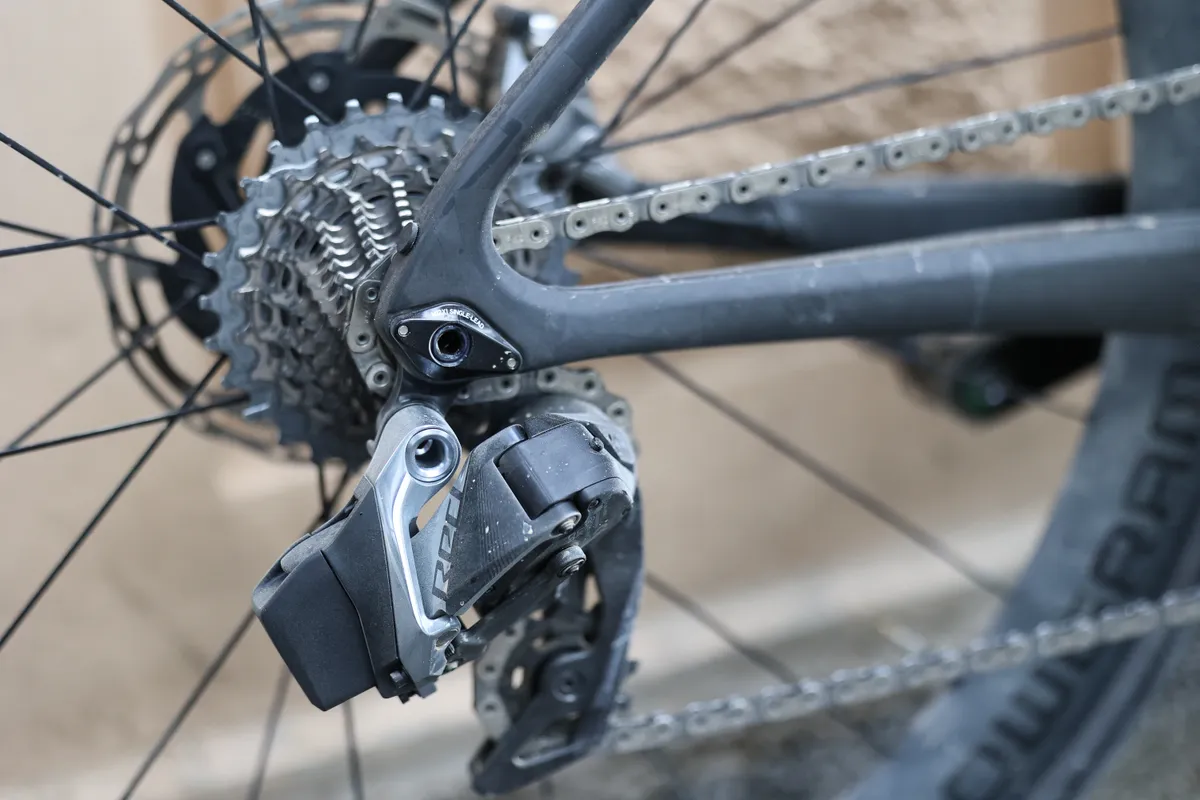
My bike was set up with a 48/35t crankset and a 10-28t cassette, which equates to a slightly more generous easiest gear than a more traditional 52/36t crankset with an 11-28t cassette.
However, I’d switch to SRAM’s 10-33t cassette in a heartbeat if heading back to Strade Bianche.
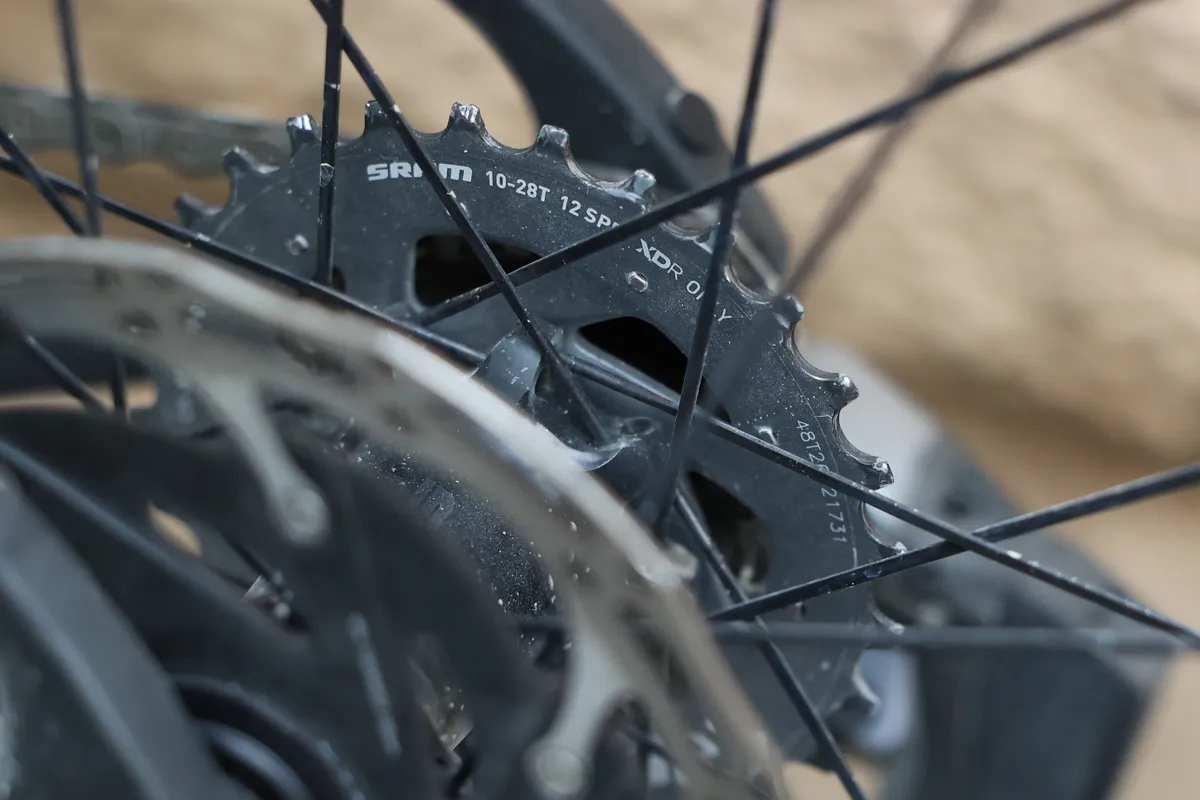
With nearly 2,500m of ascent across the 138km ride, there’s no shortage of climbing – and, crucially, a disproportionate amount of that is on the steep stuff.
Add in gravel climbs where traction and momentum can be challenging, and you can start to understand why you might need an 'easier' gear than expected.
Aero overload
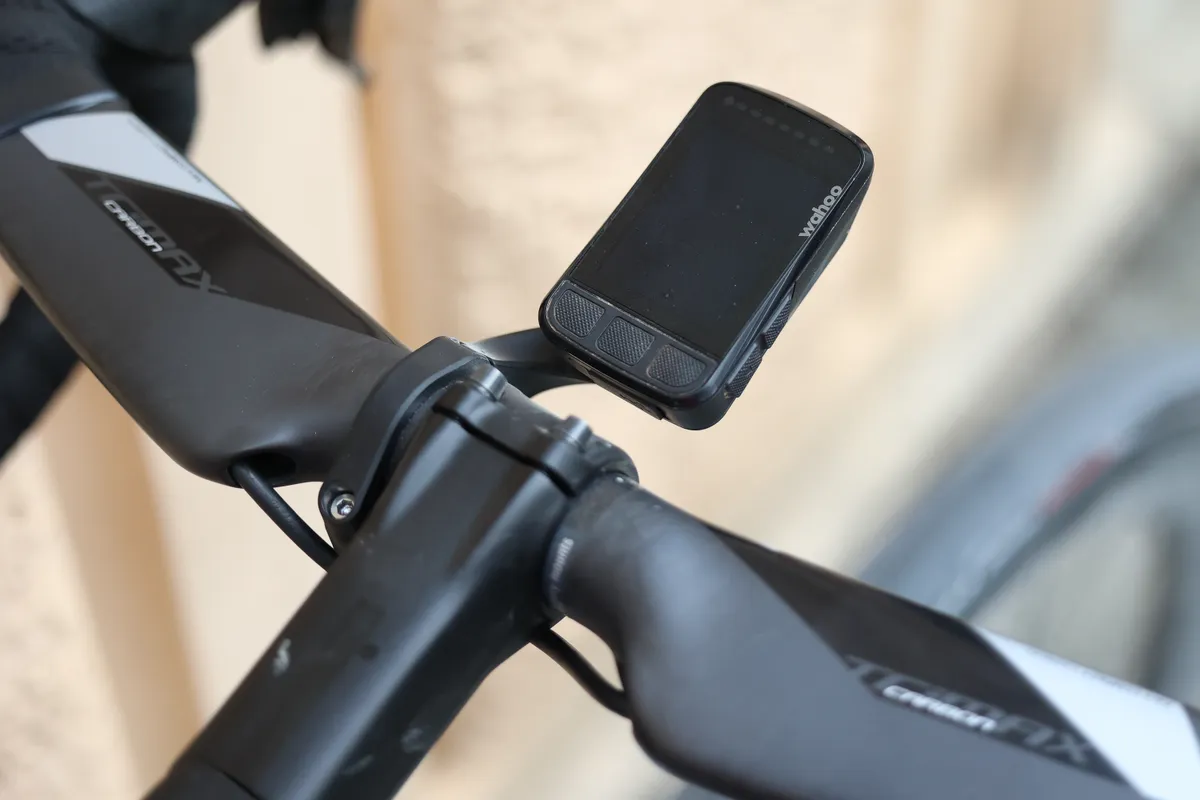
As I’ve already mentioned, the Cannondale SuperSix is a finely-tuned race machine, but there are two aero build details I could do without.
First, the extended depth of the Vision Trimax Carbon Aero handlebar makes it harder work to grip the tops of the bar than I’d like. It was fine as a support for resting the hands on the tops, but too deep to wrap my fingers around comfortably – for my dainty hands, at least. I’d swap in a more ergonomic bar if this were my bike.
Second, with this latest version of the SuperSix, Cannondale introduced the ‘Aero Gripper’ bottle and cage combination. The cages sit within the boundaries of the down tube and, combined with the flattened profile of the bottles, keep everything hidden from the wind.
I found the bottles harder to grab on the fly during my final shakedown ride, so swapped in standard round bottles (the Aero Gripper cages are compatible with standard bottles).
The aero bottles might be something you get used to over time, but I didn’t want to have any concerns about grabbing a bottle quickly when tired during the gran fondo and was happy to pass on the claimed three-watt saving.
Tyre tweaks
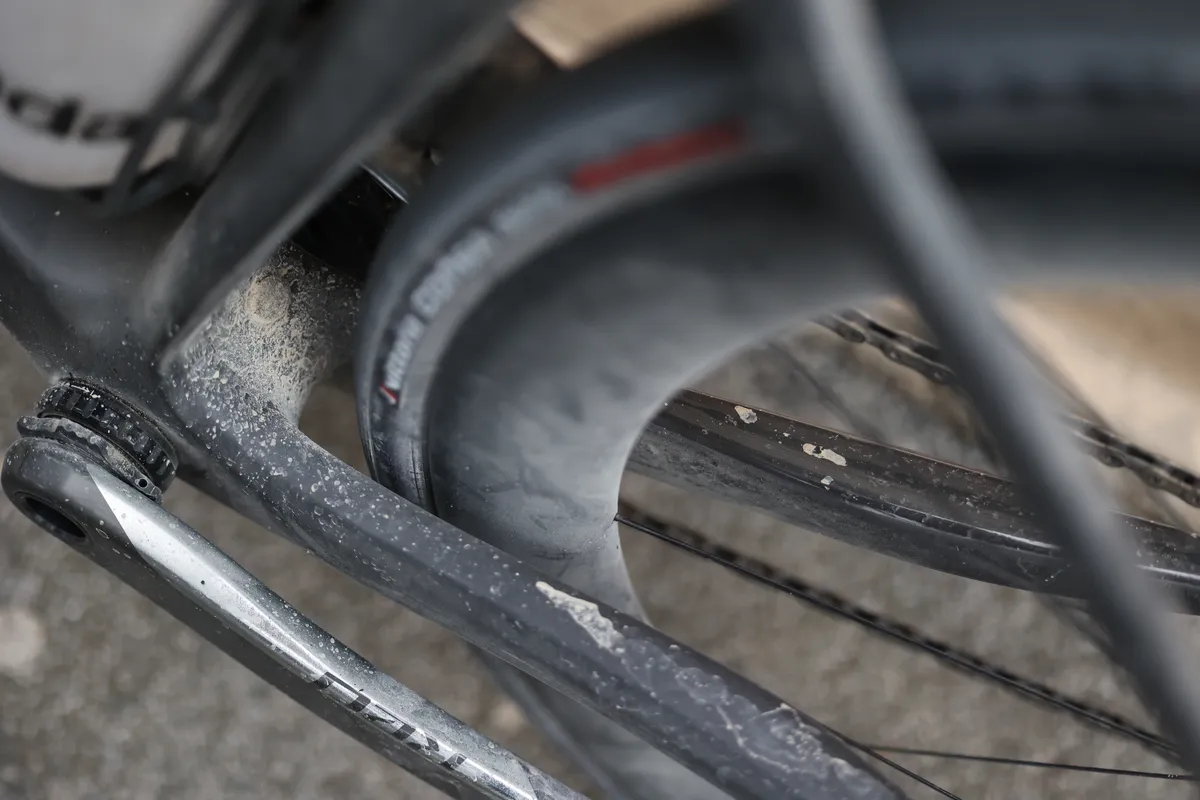
Ultimately, I had no significant complaints with my tyre setup – having switched from 28c to 30c in advance of the event – but I would drop the pressure for a return to Tuscany.
I opted for around 74psi / 5.1 bar for my 77kg weight but, given the fact that 41.8km of the 138.5km gran fondo course was unpaved, I’d be confident in dropping that further to gain a little more comfort and control on the rougher sections (particularly if set up tubeless), without having any real impact on rolling speed.
What about a wider tyre? Given the latest SuperSix can accommodate 34c rubber, I’d certainly consider dropping a bigger tubeless tyre in there for as smooth a ride as possible but, as I've already mentioned, the 30c Vittoria Corsa Control tyres did just fine.
